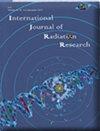伊拉克库尔德斯坦地区杜霍克市选定住宅室内氡浓度估算及氡及其子体剂量评价
IF 0.4
4区 医学
Q4 RADIOLOGY, NUCLEAR MEDICINE & MEDICAL IMAGING
引用次数: 2
摘要
背景:在天然放射源中,活体组织接受的辐射剂量中有三分之二是由氡及其子体引起的,因为氡在吸入或摄入时会与生物组织发生相互作用。因此,本研究计划在研究计量参数的基础上,对室内氡进行测量和剂量评价,了解两者之间的相关性。材料与方法:本研究采用短期和长期两种不同的方案对室内氡浓度进行了研究。在短期内,使用RAD7探测器和Airthings Corentium监测仪在冬季和夏季初对杜胡克市的七所住宅的氡浓度进行了测量。估算了氡及其衰变产物对居民的年有效剂量。在长期方案中,通过在一栋建筑物内固定Corentoum检测仪,连续一年测量氡浓度。结果:冬季氡浓度高于夏季;量程为1 - 56 Bq m - 3。两季室内氡浓度平均值为19±6.1 Bq m - 3。氡及其子代的年平均有效剂量冬季分别为0.59±0.17和0.23±0.14 mSv y - 1,夏季分别为0.37和0.15 mSv y - 1。结论:室内氡平均浓度测定结果明显低于ICRP规定的作用水平。氡浓度与风速呈负相关,与室外温度呈正相关,室外湿度的影响几乎被忽略。本文章由计算机程序翻译,如有差异,请以英文原文为准。
Estimation of indoor radon concentration and dose evaluation of radon and its progeny in selected dwellings in Duhok city, Kurdistan Region, Iraq
Background : Among the natural radioactive sources, two - thirds of radiation dose received by living tissue is caused by radon and its progeny because it can interact with biological tissue when it is inhaled or ingested. Accordingly, this study planned to measure indoor radon and evaluates its doses in addition to studying metrological parameter to understand the correlation between them. Materials and Methods : This study focused on the indoor radon concentration by two different protocols which are short term and long term. In short term, radon concentration was measured in seven dwellings in Duhok city at the beginning of both winter and summer using RAD7 detector and Airthings Corentium monitor. Then annual effective dose of radon and its decay product to the inhabitance were estimated. In long term protocol, radon concentration was measured continually for one year by fixing Corentoum detector in one building. Results : outcomes showed that the concentration of radon is higher in winter than summer; with range of 1 - 56 Bq m - 3 . The average level of indoor radon concentration in both seasons was 19 ± 6.1 Bq m - 3 . The radon and its progeny average annual effective dose were 0.59 ± 0.17 and 0.23 ± 0.14 mSv y - 1 in winter and 0.37 and 0.15 mSv y - 1 in summer respectively. Conclusion : The results of average indoor radon concentration obtained were considerably less than the action levels prescribed by ICRP. Also, the results indicated that radon concentration negatively correlated with wind speed and positively with outdoor temperature while outdoor humidity effect has almost neglected.
求助全文
通过发布文献求助,成功后即可免费获取论文全文。
去求助
来源期刊

International Journal of Radiation Research
RADIOLOGY, NUCLEAR MEDICINE & MEDICAL IMAGING-
CiteScore
1.10
自引率
33.30%
发文量
42
期刊介绍:
International Journal of Radiation Research (IJRR) publishes original scientific research and clinical investigations related to radiation oncology, radiation biology, and Medical and health physics. The clinical studies submitted for publication include experimental studies of combined modality treatment, especially chemoradiotherapy approaches, and relevant innovations in hyperthermia, brachytherapy, high LET irradiation, nuclear medicine, dosimetry, tumor imaging, radiation treatment planning, radiosensitizers, and radioprotectors. All manuscripts must pass stringent peer-review and only papers that are rated of high scientific quality are accepted.
 求助内容:
求助内容: 应助结果提醒方式:
应助结果提醒方式:


